How To Install Acoustic Panels On Wall
Expert step-by-step do-it-yourself communication on how to install sheet paneling, including preparation.
At that place is a paneling style for near every decor. Choices include rustic boards, frame-and-console designs with or without molding, and elaborate raised panels. You can cover an unabridged wall or choose waist- or shoulder-high wainscoting.
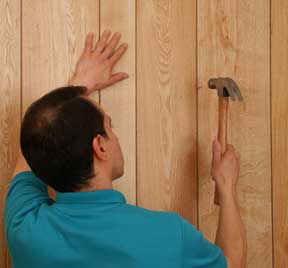
Paneling can be fabricated from fine hardwoods or inexpensive pine. Finishes run the gamut equally well. Panels can be given a articulate cease, or they can be painted, stained, or coated with whatsoever number of decorative finishes.
Paneling is sold in two forms: sheets and boards. Sheets are typically 4 by 8 feet. Boards range from 3/8 to 7/8 inch in thickness, just the nigh common are 1/two and iii/4 inch. Boards come in widths of between 3 and ten inches and may have either square, tongue-and-groove, or shiplap edges.
Earlier installing paneling, identify the materials in the room where they volition be installed for 2 to five days to allow the woods to adjust to the humidity level. This will assistance eliminate any shrinkage or expansion problems once the panels are secured to the wall.
Preparing the Wall
When applying sheet or lath panels over a finished woods-frame wall, you may be able to attach the textile through the wallboard or plaster to the wall studs; otherwise, you lot volition have to adhere furring strips—ane by 3s or one by 4s—to the studs as a base for securing the panels. If the wall is new and without wallboard or plaster, you tin attach sheets or boards directly to the studs or to 2-by-4 blocks nailed betwixt the studs. If you do adhere furring strips to the wall studs, employ nails long plenty to penetrate them past at least 1 inch. Fasten the strips to masonry walls using physical nails or screws and shield-type masonry anchors.
To ensure that the siding volition sit down flat on the wall, furring strips should be plumb and flat; you can make adjustments with cedar-shingle shims wedged behind the furring strips every bit needed. Get out a i/4-inch space at both the pinnacle and bottom of the wall when applying the strips to allow for unevenness in the floor or ceiling.
Note that furring strips and paneling will add together to the thickness of the wall. Window and door jambs must exist congenital out to compensate for this. It is probable that you volition have to add extensions to electrical switches and receptacle boxes, besides.
Installing Sheet Paneling
Cutting each canvass 1/4 inch shorter than the distance from the floor to the ceiling. Utilise adhesive to the framing in a wavy pattern. Drive four finishing nails through the top edge of the panel. Position the panel on the wall, leaving a i/4-inch space at the bottom, and bulldoze the 4 nails partway into the wall. Pull the bottom edge of the panel about 6 inches from the wall and push a cake behind the sheet. When the adhesive is tacky. Remove the block and press the console firmly into place past hit it with a rubber mallet or past hammering against a padded block. Bulldoze the top-edge nails all the way in, and then nail the console at the bottom and, if needed, through the grooves at stud locations. Embrace the nailheads and the i/four-inch gap with molding.
Plumbing fixtures a panel around any opening requires careful measuring, marking, and cut. Keep track of all the measurements past sketching them on a piece of newspaper.
Starting from the corner of the wall or the edge of the nearest panel, measure out to the edge of the opening or electrical box. And so, from the same point, measure out out to the opening's opposite edge. Side by side, measure the distance from the floor to the opening's bottom border and from the flooring to the opening'due south pinnacle edge. (Call up that y'all volition install the paneling 1/4 inch above the flooring.) Transfer these measurements to the panel, marking the side of the panel that will face you as you cut (face up for a handsaw, face down for a power saw).
i With a helper, position the showtime console at i corner of the room, but do non apply panel adhesive yet. Check the inside edge of the panel with a level to make sure it is plumb.
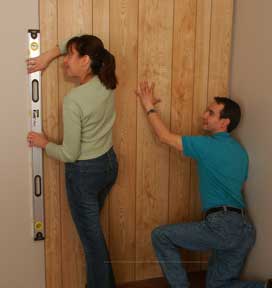
ii While your helper holds the panel in place, use a compass or scribe tool to scribe the corner border of the panel so that it tin can be cut to fit snugly against the adjoining wall. Draw the compass along the bordering wall so the pencil leg duplicates the unevenness onto the panel.
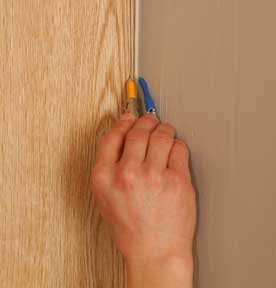
3 Cutting the marked border along the pencil line. A saber saw works best for this, but yous will demand to utilise a fine-toothed blade to avert fraying the forepart of the panel. Or, you tin can transfer the mark to the backside and cut the panel on that side.
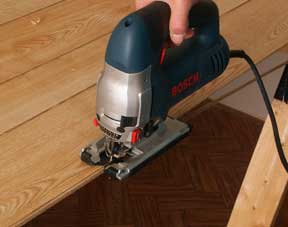
4 Attach the panel to the wall, placing nails in the dark grooves where they're least likely to exist visible. Stop hammering before the nailhead reaches the surface, and set the head flush with a nailset.

v When a console must be cut for a switch or receptacle, hold the panel in position confronting the electric box and marking the box's location. Snap chalk lines to the approximate place where the box will go. And so measure the distance from the edge of the adjoining installed panel to both sides of the box and transfer these dimensions onto the panel between the chalk lines.
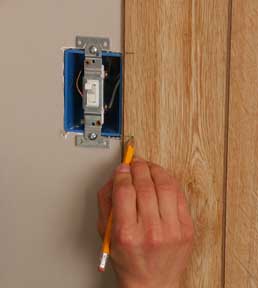
half-dozen Make cutouts for electrical boxes using a saber saw equipped with a fine cut bract.
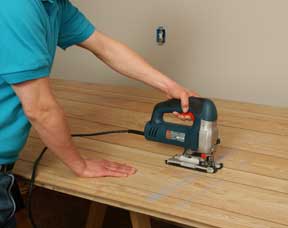
![]() Featured Resource: Find a Pre-Screened Local Wall Framing Contractor
Featured Resource: Find a Pre-Screened Local Wall Framing Contractor
Source: https://www.hometips.com/diy-how-to/wall-paneling-install.html
Posted by: bakerlifuld1961.blogspot.com


0 Response to "How To Install Acoustic Panels On Wall"
Post a Comment